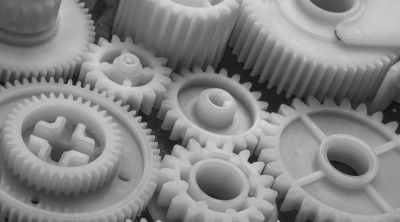Helios Offers Hobbing Solutions for Plastic Gears
External plastic gears, like their metal counterparts, use the hobbing process for productive manufacturing. However, the difference in material leads manufacturers to key considerations to ensure successful hobbing applications. Plastic gears tend to be ultra-fine- (finer than ~64 DP) to fine-pitch (finer than 20 DP); their material strength can be compromised; order volumes tend to be high; chip evacuation requires a special system; and burr mitigation is a must. Decades of experience from Helios Gear Products address these issues as follows.
To productively manufacture fine- and ultra-fine-pitch gears — which plastic gears often are — the hobbing machine must offer high speeds. Contemporary hobbing platforms for these types of gears offer hob spindles up to and exceeding 10,000 rpm. At first thought, this may seem excessive, but speed requirements stem from surface speed requirements. For instance, when using a carbide hob, a common starting point for speed may be 250 m/min (820 sfm). Consider that some contemporary CNC hobbing platforms offer only 2,000 rpm tool spindles; the following chart demonstrates how this limits achievable speeds when using hobs less than approximately 40 mm diameter. Thus, to ensure productive manufacturing of ultra-fine to fine-pitch plastic gears, high-speed tool spindles are a must, such as those offered on the hobbing models Hera 30 (10,000 rpm) or the Monnier + Zahner 500 D-drive (12,000 rpm).
The material of small parts can be easily compromised under clamping pressure when mounted for hobbing. Hydraulic pressure is typically needed, but when trying to avoid part slipping, such clamping forces can crush, mushroom, or unacceptably deform a workpiece. Dual direct-drive work spindles offer help to alleviate this problem. With this ability, the machine’s work spindle (headstock) and tailstock are both directly driven by CNC motors that are kept in a synchronized timing. This helps remove frictional forces during clamping, which allows easier fixturing with less clamping force. Consequently, dual direct-drive work spindles allow fixturing of very small workpieces with reduced clamping force.
Because plastic gear orders are often large-volume, manufacturers must consider automation capabilities of the hobbing machine. Small (or very small!) workpieces require a variety of automatic loaders depending on their geometry. Although robots are prevalent today, they typically lack the dexterity and/or clearances to handle these parts. As such, manufacturers must familiarize themselves with more specialized automation systems, such as gantries, bowl feeders, magazines, conveyors, line feeders, and more. Each system offers benefits and limitations for the manufacturer to weigh for his applications, so he must speak with the applications engineers from the machine tool’s factory to learn more. Less ideally, a third party automation solution can also be considered, but this will add complexity to the hobbing solution.
As with metal gears, burrs produced by the hobbing operation must be removed. Most hobbing machines offer a dedicated deburring disc that shears away burrs during the hobbing cycle. Because this adds no time to the machining cycle, it should be used whenever possible. However, such discs may still leave micro-burrs, which may not be acceptable for the finished gear. Thus, more sophisticated methods may be employed for deburring, such as single- and two-hob deburring. If the machine tool allows a negative center distance — i.e., the tool spindle can reach “over” the work axis — then the same hob that performed the hobbing operation can also deburr the same gear. This is performed on the hobbing machine (such as those offered by Monnier + Zahner), with the same clamping, within the same cycle, which is a huge benefit gained at the cost of a few seconds of cycle time and a bit of extra programming during setup. Machines that cannot hob “beyond zero” (for one-hob deburring) may offer sufficient hob shifting with special software to use two-hob deburring. In this operation, two hobs are mounted on the same hob arbor, each performs a typical hobbing cycle, but the second hob cuts and feeds in an opposite direction. As a result, each hobbing pass pushes chips toward the middle of the part, thus avoiding burrs. As with one-hob deburring, two-hob deburring uses the same clamping within the same cycle as the hobbing process, so it is a very productive means of deburring plastic gears.
An example of two-hob deburring can be seen at https://heliosgearproducts.com/two-hob-deburring-plastic-gear-hera-30/. Other means of deburring are available but may require additional machines and/or operations. Such complexity can be avoided by choosing a hobbing machine with “built-in” deburring abilities.
Applications engineers from Helios Gear Products discuss the above strategies with manufacturers when they choose an optimal hobbing platform for plastic gears. Such decisions consider key factors such as the machine’s ability to effectively clamp small workpieces by using dual direct-drive work spindles. Because plastic is not a ferrous material, the hobbing platform must adequately handle chips without a traditional magnetic conveyor. Automation systems and their versatility should be discussed for the manufacturer’s particular applications, as should deburring methods. Finally, choosing a hobbing solution with high-speed spindles will help future-proof the platform to handle a wide range of applications, and it will future-proof for tomorrow’s more aggressive cutting tool materials and coatings.





